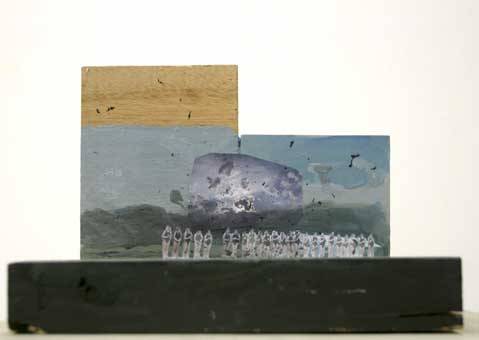Helen Verhoeven
20 Jan - 24 Feb 2007
HELEN VERHOEVEN
"The Beautiful Many"
Galerie Fons Welters presents a solo exhibition of work by Helen Verhoeven (Leiden, 1974). Verhoeven, who studied in San Francisco and New York, completed her training at the Rijksakademie at the end of 2006. Her work consists of oil on canvas, as well as scale models, drawings, ceramic figures, dolls, manipulated photographs, and found images. At Galerie Fons Welters Verhoeven is exhibiting recent paintings of varying sizes along with a number of her scale models.
Helen Verhoeven’s mysterious imagery is always the product of extensive research, transcending historical and cultural boundaries. She draws on clinical studies, personal interviews, historical and scientific archives, the internet, art history, and most recently, hagiography. Verhoeven's secular study of Christian saints opened up a wide range of sources: from Outsider Art and Sienese icon paintings to Bible illustrations. Verhoeven combines images of this kind associatively with modern images from newspapers, magazines, nature documentaries and even puppet shows. She then uses the computer or hand-made models to create her own entirely new, innovative versions of canonised figures or phenomena, incorporating spatial experiments.
Earlier on, Verhoeven painted her images in the form of series, with shifts in perspective. Her interest in art made in the early Middle Ages, from which perspective is largely absent, has led to a convergence of different kinds of three-dimensionality and perspective in individual works. In models or dioramas, she manipulates scale and distorts perspective. This frequently gives her paintings an alienating appearance, in which time and space seem to have gone awry, in which anything is possible.
A great deal is possible indeed, in the world of Helen Verhoeven. In shifting perspective and with countless references, The Beautiful Many provides enigmatic images, varying from desolate landscapes to crowded scenes of men, women, bikini girls or animals. There is frequently a suggestion of movement, inspired by waterfalls, waves and processions. In addition, every image provides material for a story. But Verhoeven's movements and stories are suspended, reduced to a moment of contemplation. What we see is a transitional period, in which groups or phenomena appear to anticipate a subsequent movement. In this way, Verhoeven draws our attention to such elementary concepts as waiting and leaving, even life and death - concepts as timeless as they are universal. These are the movements of human beings, of history and nature.
There is nothing unequivocal about Helen Verhoeven's images. Her free use of both subject and elements of time and space creates a distance to the image that attracts our attention. In an atmosphere of endlessness, the phenomena depicted, whether familiar or unrecognisable, are not immediately understood. The viewer is invited to associate, just as the artist has done in creating her work. Within the stillness that Verhoeven's paintings depict and evoke, this is pure enjoyment.
[Saskia van der Kroef]
© Helen Verhoeven
"The Beautiful Many"
Galerie Fons Welters presents a solo exhibition of work by Helen Verhoeven (Leiden, 1974). Verhoeven, who studied in San Francisco and New York, completed her training at the Rijksakademie at the end of 2006. Her work consists of oil on canvas, as well as scale models, drawings, ceramic figures, dolls, manipulated photographs, and found images. At Galerie Fons Welters Verhoeven is exhibiting recent paintings of varying sizes along with a number of her scale models.
Helen Verhoeven’s mysterious imagery is always the product of extensive research, transcending historical and cultural boundaries. She draws on clinical studies, personal interviews, historical and scientific archives, the internet, art history, and most recently, hagiography. Verhoeven's secular study of Christian saints opened up a wide range of sources: from Outsider Art and Sienese icon paintings to Bible illustrations. Verhoeven combines images of this kind associatively with modern images from newspapers, magazines, nature documentaries and even puppet shows. She then uses the computer or hand-made models to create her own entirely new, innovative versions of canonised figures or phenomena, incorporating spatial experiments.
Earlier on, Verhoeven painted her images in the form of series, with shifts in perspective. Her interest in art made in the early Middle Ages, from which perspective is largely absent, has led to a convergence of different kinds of three-dimensionality and perspective in individual works. In models or dioramas, she manipulates scale and distorts perspective. This frequently gives her paintings an alienating appearance, in which time and space seem to have gone awry, in which anything is possible.
A great deal is possible indeed, in the world of Helen Verhoeven. In shifting perspective and with countless references, The Beautiful Many provides enigmatic images, varying from desolate landscapes to crowded scenes of men, women, bikini girls or animals. There is frequently a suggestion of movement, inspired by waterfalls, waves and processions. In addition, every image provides material for a story. But Verhoeven's movements and stories are suspended, reduced to a moment of contemplation. What we see is a transitional period, in which groups or phenomena appear to anticipate a subsequent movement. In this way, Verhoeven draws our attention to such elementary concepts as waiting and leaving, even life and death - concepts as timeless as they are universal. These are the movements of human beings, of history and nature.
There is nothing unequivocal about Helen Verhoeven's images. Her free use of both subject and elements of time and space creates a distance to the image that attracts our attention. In an atmosphere of endlessness, the phenomena depicted, whether familiar or unrecognisable, are not immediately understood. The viewer is invited to associate, just as the artist has done in creating her work. Within the stillness that Verhoeven's paintings depict and evoke, this is pure enjoyment.
[Saskia van der Kroef]
© Helen Verhoeven

